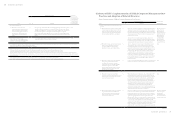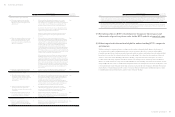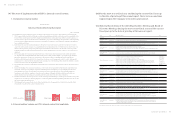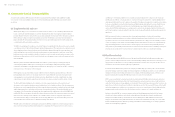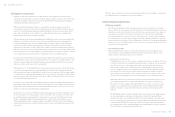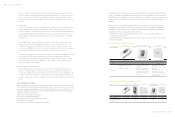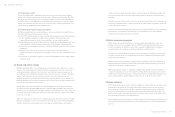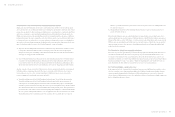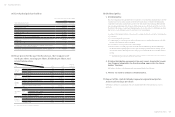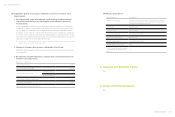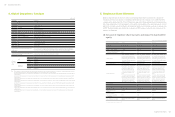HTC 2015 Annual Report Download - page 57
Download and view the complete annual report
Please find page 57 of the 2015 HTC annual report below. You can navigate through the pages in the report by either clicking on the pages listed below, or by using the keyword search tool below to find specific information within the annual report.Corporate governance
Corporate governance
110
111
4.1.3 Sustainable product
In2013,theHTCOne(M7),ouragshipproduct,wasselectedtopassproductcarbonfootprint
verification by a third party verification organization under collaboration with suppliers. The HTC
One(M7)becametherstsmartphonetocomplywithinternationalstandards,includingISO/TS
14067:2013,PAS2050:2011,ISO14040:2006andISO14044:2006,withrespecttocarbonfootprint
andlifecycleevaluationsofproducts.In2015,wecompletedproductcarbonfootprintandlifecycle
evaluationsfortheHTCOneM9andtheHTCDesire820.
Recorded footprint related programs and reports
HTC has been analyzing the environmental influence of our products via life cycle evaluation since
2010. The action schemes in these years are as follows:
a) In2010,HTCparticipatedinthe“GuidanceProgramofInformationDisclosureforEnvironmental
Product”heldbytheIndustrialDevelopmentBureau,MinistryofEconomicAairs,and
completedEnvironmentalProductDeclaration(EPD)incooperationwith19suppliers.
b) In2011,HTCparticipatedinthe“GuidanceProgramofLowCarbonProductDesignSystem”,and
completed guidance of carbon footprint analysis and low carbon design for 15 main suppliers.
c) In2013,HTCcooperatedwith11supplierstocompletetheISO/TS14067productcarbonfootprint
examination.
d) In2014,themainactionschemedirectlyfocusedonprovidingdetaileddataoflifecycle
examinationanalysistomainsuppliersforsettinguptheobjectivetoreducecarbonandtheaction
scheme.
e) In2015,HTCcooperatedwith8supplierstocompletetheISO/TS14067productcarbonfootprint
examination again.
4.2 Energy and climate change
HTCimplementedtheISO50001energymanagementsystemin2011togainafullpictureofinternal
energy use, the relevant regulatory requirements and the energy baseline to provide a reference for
ourenergyperformanceindicatorsaswellassetshort-,mid-andlong-termimprovementgoals.In
2009, HTC introduced the GHG emission inventory and disclosure for factories and oces throughout
Taiwan. To this end, we have devised a dual-aspect strategy composed of adopting an energy
management system and performing energy-saving practices. On one hand we strive to optimize our
management system to reduce energy consumption, and on the other we use energy-saving technology
to improve the energy eciency of our products.
TotalgreenhousegasemissionsbyHTCwere42,489.88tCO2ein2015.Themajorityofemittedgas
wereCO2.ItisnotablethatHTC’sGHGemissionscontainednoPFCs,SF6,SOXorotherwastegases,
andHTCdoesnotuseanysubstancesthatmightendangertheozonosphere.Moreover,thecoolingand
air-conditioningsystemsinHTC’snewbuildingalluseenvironmentfriendlycoolantR-134atofurther
preserve the ozonosphere.
HTC is not a heavy energy consumer. However, within a manageable range of its operations, it is taking
initiatives in realizing the concepts of energy-eciency and reduction of carbon emission by utilizing
renewable energy. We set up solar panels on top of our employee dormitory, where solar radiation
could be converted to thermal energy for supply to water heating systems. The thermal energy would
be stored in a tank for supply of hot water to showering equipment, eectively reducing our usage of
natural gas.
With the eective use of solar optoelectronics, the total saving of natural gas for 2015 accounted for was
56,436degrees,whichtranslatestoareductionof106,043kgofCO2 emission, equivalent to the amount
of carbon absorbed by 5,892 trees.
Apart from the regular annual GHG emission inventory and verification, HTC also reports our planning
and systems for carbon risk and carbon management on an annual basis in accordance with the
requirementsoftheCarbonDisclosureProject(CDP).
4.3 Water resource management
Climate change due to global warming has become increasingly evident making the storage and
distribution of water resources an important issue. At HTC, even though our production processes
are not water intensive, we still strive to reduce water consumption during routine consumption
encouraging our people to maintain good water management, recycling, and reuse.
All of the water consumed during our operations comes from tap water. As all factory production lines
are dry processes that produce no industrial wastewater, water consumption is all from general oce
and domestic use by employees.
Owing to a significant area of green space and plants situated within factory perimeters, HTC achieves
irrigation by using recycled sewage and retreatment optimization without increasing tap water usage.
In2015,theactualsewagerecyclingratewas69%.
HTC also established a rainwater recycling system equipped with computer monitoring equipment to
continuouslysummarizeandmonitortherainwaterrecyclingsituation.SinceAugust,2013,collected
rainwater and condensate water from air conditioners have been treated, which has been implemented
in areas such as sanitation and in the irrigation of plants in order to eectively conserve water.
4.4 Waste reduction
HTC’s main production process is the assembly of smartphones. The production process generates only
tiny amounts of emissions from soldering. No NOx or SOx emissions are generated. The production
process produces no hazardous waste. We have strengthened our waste management and disposal
modelinaccordancewiththeinternal“IndustrialWasteDisposalandManagementProcedure”.We
alsopracticethoroughrecyclingandeducation.Properdisposalofwasteensuresthecleanlinessofthe
work environment and reduces environmental impact.
On the management level, we adhered to government regulations in contracting licensed waste disposal
companies for proper waste disposal. Contractor trucks and disposal sites are also checked at irregular
intervals.


